2020 Hyundai Tucson height
[x] Cancel search: heightPage 55 of 637
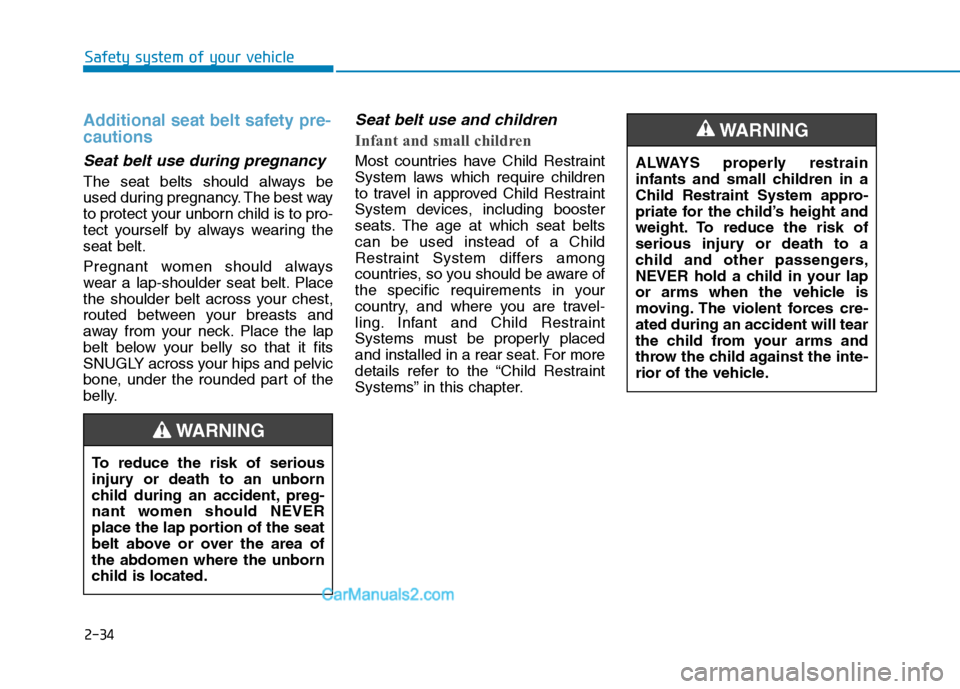
2-34
Safety system of your vehicle
Additional seat belt safety pre-
cautions
Seat belt use during pregnancy
The seat belts should always be
used during pregnancy. The best way
to protect your unborn child is to pro-
tect yourself by always wearing the
seat belt.
Pregnant women should always
wear a lap-shoulder seat belt. Place
the shoulder belt across your chest,
routed between your breasts and
away from your neck. Place the lap
belt below your belly so that it fits
SNUGLY across your hips and pelvic
bone, under the rounded part of the
belly.
Seat belt use and children
Infant and small children
Most countries have Child Restraint
System laws which require children
to travel in approved Child Restraint
System devices, including booster
seats. The age at which seat belts
can be used instead of a Child
Restraint System differs among
countries, so you should be aware of
the specific requirements in your
country, and where you are travel-
ling. Infant and Child Restraint
Systems must be properly placed
and installed in a rear seat. For more
details refer to the “Child Restraint
Systems” in this chapter.ALWAYS properly restrain
infants and small children in a
Child Restraint System appro-
priate for the child’s height and
weight. To reduce the risk of
serious injury or death to a
child and other passengers,
NEVER hold a child in your lap
or arms when the vehicle is
moving. The violent forces cre-
ated during an accident will tear
the child from your arms and
throw the child against the inte-
rior of the vehicle.
WARNING
To reduce the risk of serious
injury or death to an unborn
child during an accident, preg-
nant women should NEVER
place the lap portion of the seat
belt above or over the area of
the abdomen where the unborn
child is located.
WARNING
Page 56 of 637
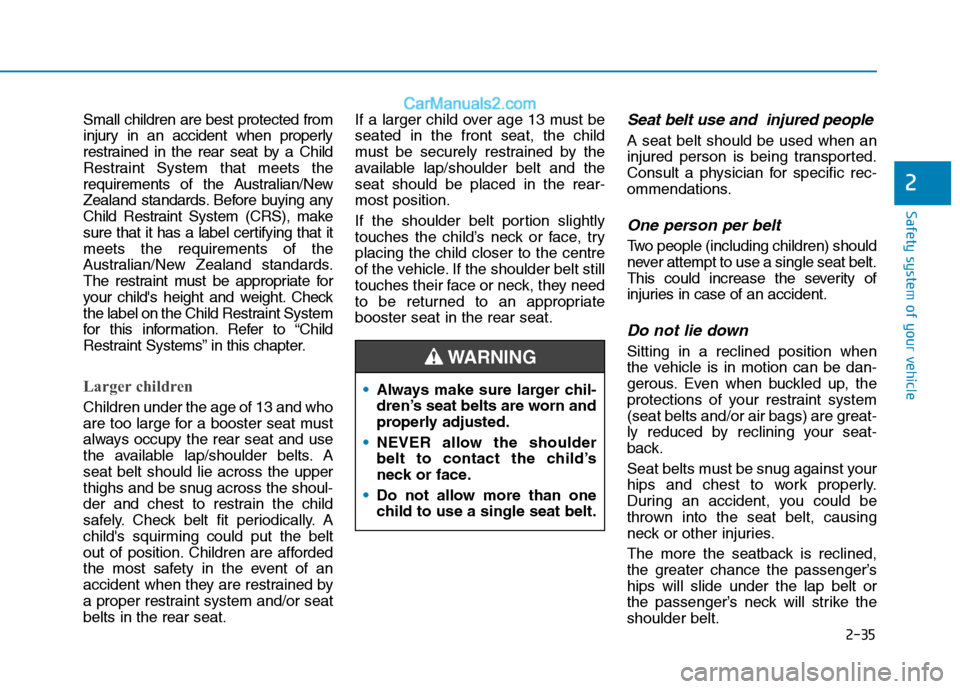
2-35
Safety system of your vehicle
2
Small children are best protected from
injury in an accident when properly
restrained in the rear seat by a Child
Restraint System that meets the
requirements of the Australian/New
Zealand standards. Before buying any
Child Restraint System (CRS), make
sure that it has a label certifying that it
meets the requirements of the
Australian/New Zealand standards.
The restraint must be appropriate for
your child's height and weight. Check
the label on the Child Restraint System
for this information. Refer to “Child
Restraint Systems” in this chapter.
Larger children
Children under the age of 13 and who
are too large for a booster seat must
always occupy the rear seat and use
the available lap/shoulder belts. A
seat belt should lie across the upper
thighs and be snug across the shoul-
der and chest to restrain the child
safely. Check belt fit periodically. A
child's squirming could put the belt
out of position. Children are afforded
the most safety in the event of an
accident when they are restrained by
a proper restraint system and/or seat
belts in the rear seat.If a larger child over age 13 must be
seated in the front seat, the child
must be securely restrained by the
available lap/shoulder belt and the
seat should be placed in the rear-
most position.
If the shoulder belt portion slightly
touches the child’s neck or face, try
placing the child closer to the centre
of the vehicle. If the shoulder belt still
touches their face or neck, they need
to be returned to an appropriate
booster seat in the rear seat.
Seat belt use and injured people
A seat belt should be used when an
injured person is being transported.
Consult a physician for specific rec-
ommendations.
One person per belt
Two people (including children) should
never attempt to use a single seat belt.
This could increase the severity of
injuries in case of an accident.
Do not lie down
Sitting in a reclined position when
the vehicle is in motion can be dan-
gerous. Even when buckled up, the
protections of your restraint system
(seat belts and/or air bags) are great-
ly reduced by reclining your seat-
back.
Seat belts must be snug against your
hips and chest to work properly.
During an accident, you could be
thrown into the seat belt, causing
neck or other injuries.
The more the seatback is reclined,
the greater chance the passenger’s
hips will slide under the lap belt or
the passenger’s neck will strike the
shoulder belt. Always make sure larger chil-
dren’s seat belts are worn and
properly adjusted.
NEVER allow the shoulder
belt to contact the child’s
neck or face.
Do not allow more than one
child to use a single seat belt.WARNING
Page 58 of 637
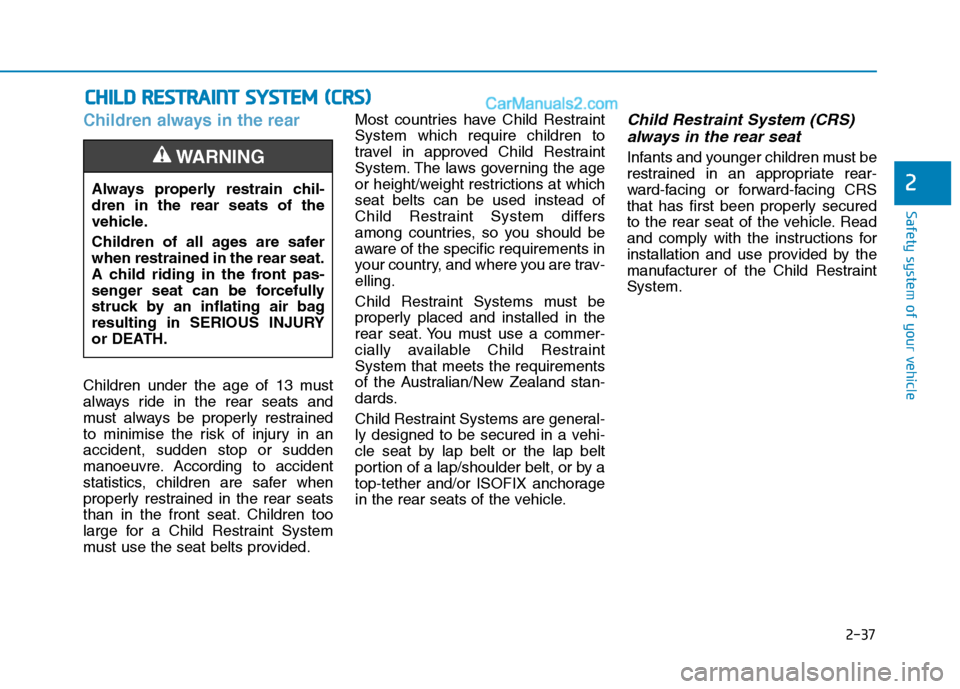
2-37
Safety system of your vehicle
2
Children always in the rear
Children under the age of 13 must
always ride in the rear seats and
must always be properly restrained
to minimise the risk of injury in an
accident, sudden stop or sudden
manoeuvre. According to accident
statistics, children are safer when
properly restrained in the rear seats
than in the front seat. Children too
large for a Child Restraint System
must use the seat belts provided.Most countries have Child Restraint
System which require children to
travel in approved Child Restraint
System. The laws governing the age
or height/weight restrictions at which
seat belts can be used instead of
Child Restraint System differs
among countries, so you should be
aware of the specific requirements in
your country, and where you are trav-
elling.
Child Restraint Systems must be
properly placed and installed in the
rear seat. You must use a commer-
cially available Child Restraint
System that meets the requirements
of the Australian/New Zealand stan-
dards.
Child Restraint Systems are general-
ly designed to be secured in a vehi-
cle seat by lap belt or the lap belt
portion of a lap/shoulder belt, or by a
top-tether and/or ISOFIX anchorage
in the rear seats of the vehicle.
Child Restraint System (CRS)
always in the rear seat
Infants and younger children must be
restrained in an appropriate rear-
ward-facing or forward-facing CRS
that has first been properly secured
to the rear seat of the vehicle. Read
and comply with the instructions for
installation and use provided by the
manufacturer of the Child Restraint
System.
C CH
HI
IL
LD
D
R
RE
ES
ST
TR
RA
AI
IN
NT
T
S
SY
YS
ST
TE
EM
M
(
(C
CR
RS
S)
)
Always properly restrain chil-
dren in the rear seats of the
vehicle.
Children of all ages are safer
when restrained in the rear seat.
A child riding in the front pas-
senger seat can be forcefully
struck by an inflating air bag
resulting in SERIOUS INJURY
or DEATH.
WARNING
Page 59 of 637

2-38
Safety system of your vehicle
Selecting a Child Restraint
System (CRS)
When selecting a CRS for your child,
always:
Make sure the CRS has a label
certifying that it that meets the
requirements of the
Australian/New Zealand standards.
Select a Child Restraint System
based on your child’s height and
weight. The required label or the
instructions for use typically pro-
vide this information.
Select a Child Restraint System
that fits the vehicle seating position
where it will be used.
Read and comply with the warn-
ings and instructions for installation
and use provided with the Child
Restraint System.
Child Restraint System (CRS)
types
There are three main types of Child
Restraint System: rearward-facing
seats, forward-facing seats, and
booster seats. They are classified
according to the child’s age, height
and weight.Always follow the Child
Restraint System manufactur-
er’s instructions for installa-
tion and use.
Always properly restrain your
child in the Child Restraint
System.
Do not use an infant carrier or
a child safety seat that
“hooks” over a seatback, it
may not provide adequate pro-
tection in an accident.
After an accident, we recom-
mend a HYUNDAI dealer check
the Child Restraint System,
seat belts, ISOFIX anchorages
and top-tether anchorages.
WARNING
Page 60 of 637

2-39
Safety system of your vehicle
2
Rearward-facing Child Restraint
System (CRS)
A rearward-facing Child Restraint
System provides restraint with the
seating surface against the back of
the child. The harness system holds
the child in place, and in an accident,
acts to keep the child positioned in
the Child Restraint System and
reduce the stress to the fragile neck
and spinal cord.
All children under the age of one
year must always ride in a rearward-
facing Child Restraint System. There
are different types of rearward-facing
Child Restraint System: infant-only
Child Restraint System can only be
used rearward-facing. Convertible
and 3-in-1 Child Restraint System
typically have higher height and
weight limits for the rearward-facing
position, allowing you to keep your
child rearward-facing for a longer
period of time.
Keep using Child Restraint System
in the rearward-facing position as
long as children fit within the height
and weight limits allowed by the
Child Restraint System manufactur-
er.
Forward-facing Child Restraint
System (CRS)
A forward-facing Child Restraint
System provides restraint for the
child’s body with a harness. Keep
children in a forward-facing Child
Restraint System with a harness
until they reach the top height or
weight limit allowed by your Child
Restraint System manufacturer.
Once your child outgrows the for-
ward-facing Child Restraint System,
your child is ready for a booster seat.
OLF034033ROLMB033041
Extreme hazard! Do not use a
rearward facing child restraint
on a seat protected by an air
bag in front of it!
NEVER install a child or infant
restraint system in the front
passenger’s seat.
Placing a rear-facing Child
Restraint System in the front
seat can result in SERIOUS
INJURY or DEATH if the child
restraint is struck by an inflat-
ing air bag.
WARNING
Page 85 of 637
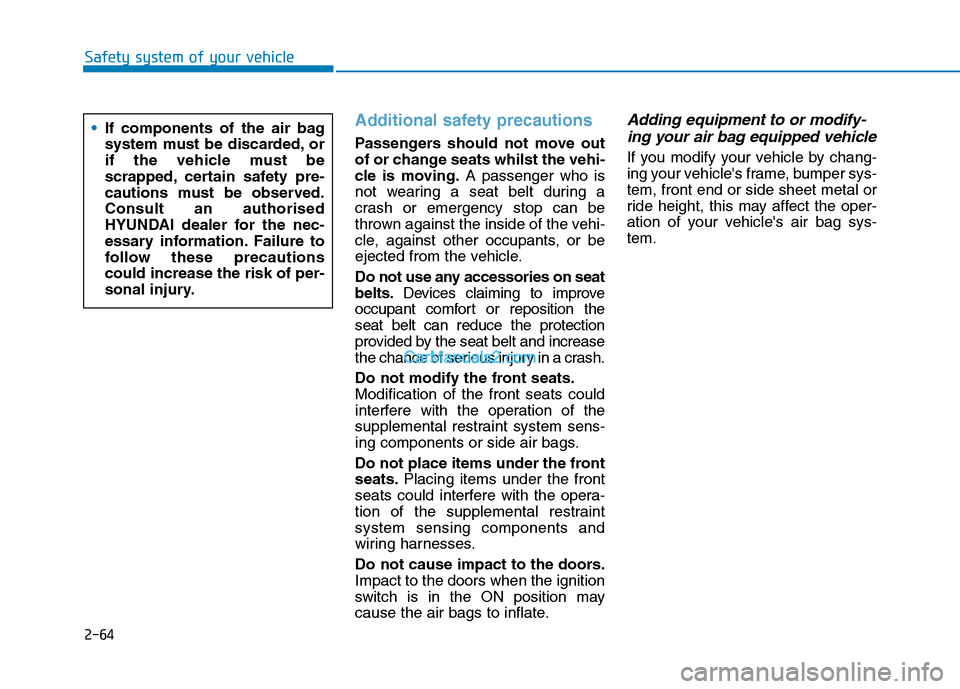
2-64
Safety system of your vehicle
If components of the air bag
system must be discarded, or
if the vehicle must be
scrapped, certain safety pre-
cautions must be observed.
Consult an authorised
HYUNDAI dealer for the nec-
essary information. Failure to
follow these precautions
could increase the risk of per-
sonal injury.
Additional safety precautions
Passengers should not move out
of or change seats whilst the vehi-
cle is moving.A passenger who is
not wearing a seat belt during a
crash or emergency stop can be
thrown against the inside of the vehi-
cle, against other occupants, or be
ejected from the vehicle.
Do not use any accessories on seat
belts.Devices claiming to improve
occupant comfort or reposition the
seat belt can reduce the protection
provided by the seat belt and increase
the chance of serious injury in a crash.
Do not modify the front seats.
Modification of the front seats could
interfere with the operation of the
supplemental restraint system sens-
ing components or side air bags.
Do not place items under the front
seats.Placing items under the front
seats could interfere with the opera-
tion of the supplemental restraint
system sensing components and
wiring harnesses.
Do not cause impact to the doors.
Impact to the doors when the ignition
switch is in the ON position may
cause the air bags to inflate.
Adding equipment to or modify-
ing your air bag equipped vehicle
If you modify your vehicle by chang-
ing your vehicle's frame, bumper sys-
tem, front end or side sheet metal or
ride height, this may affect the oper-
ation of your vehicle's air bag sys-
tem.
Page 108 of 637
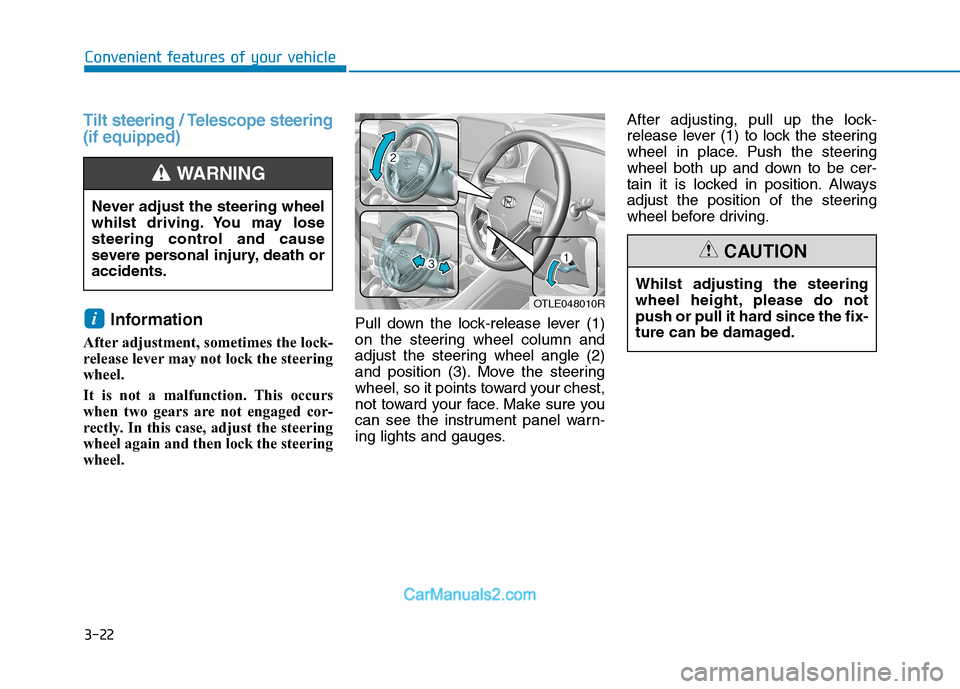
3-22
Convenient features of your vehicle
Tilt steering / Telescope steering
(if equipped)
Information
After adjustment, sometimes the lock-
release lever may not lock the steering
wheel.
It is not a malfunction. This occurs
when two gears are not engaged cor-
rectly. In this case, adjust the steering
wheel again and then lock the steering
wheel.Pull down the lock-release lever (1)
on the steering wheel column and
adjust the steering wheel angle (2)
and position (3). Move the steering
wheel, so it points toward your chest,
not toward your face. Make sure you
can see the instrument panel warn-
ing lights and gauges.After adjusting, pull up the lock-
release lever (1) to lock the steering
wheel in place. Push the steering
wheel both up and down to be cer-
tain it is locked in position. Always
adjust the position of the steering
wheel before driving.
i
Never adjust the steering wheel
whilst driving. You may lose
steering control and cause
severe personal injury, death or
accidents.
WARNING
OTLE048010R
Whilst adjusting the steering
wheel height, please do not
push or pull it hard since the fix-
ture can be damaged.
CAUTION
Page 140 of 637
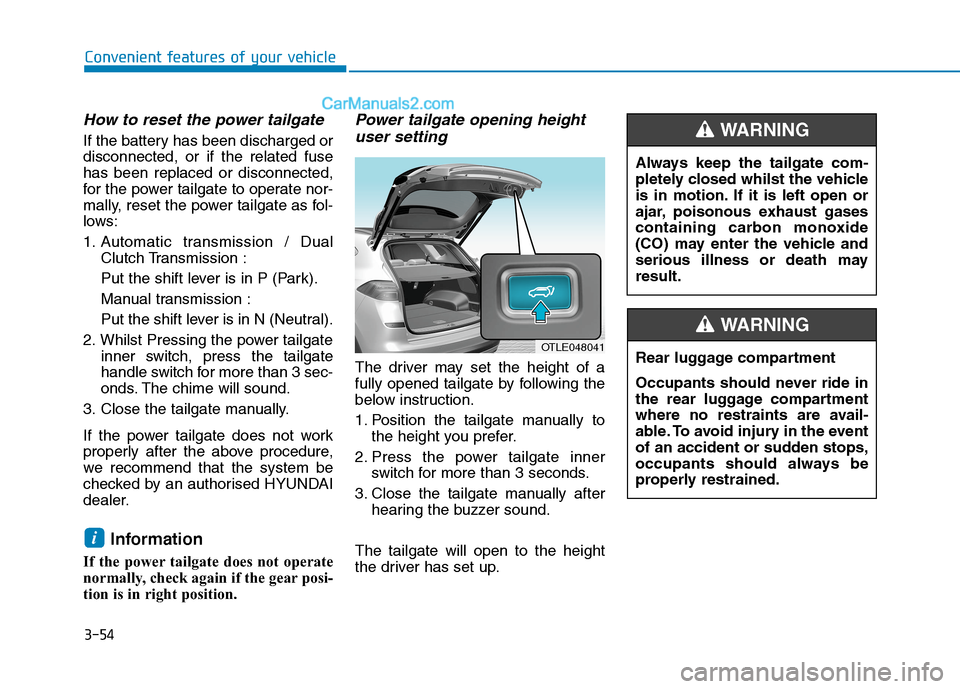
3-54
Convenient features of your vehicle
How to reset the power tailgate
If the battery has been discharged or
disconnected, or if the related fuse
has been replaced or disconnected,
for the power tailgate to operate nor-
mally, reset the power tailgate as fol-
lows:
1. Automatic transmission / Dual
Clutch Transmission :
Put the shift lever is in P (Park).
Manual transmission :
Put the shift lever is in N (Neutral).
2. Whilst Pressing the power tailgate
inner switch, press the tailgate
handle switch for more than 3 sec-
onds. The chime will sound.
3. Close the tailgate manually.
If the power tailgate does not work
properly after the above procedure,
we recommend that the system be
checked by an authorised HYUNDAI
dealer.
Information
If the power tailgate does not operate
normally, check again if the gear posi-
tion is in right position.
Power tailgate opening height
user setting
The driver may set the height of a
fully opened tailgate by following the
below instruction.
1. Position the tailgate manually to
the height you prefer.
2. Press the power tailgate inner
switch for more than 3 seconds.
3. Close the tailgate manually after
hearing the buzzer sound.
The tailgate will open to the height
the driver has set up.
i
OTLE048041
Always keep the tailgate com-
pletely closed whilst the vehicle
is in motion. If it is left open or
ajar, poisonous exhaust gases
containing carbon monoxide
(CO) may enter the vehicle and
serious illness or death may
result.
WARNING
Rear luggage compartment
Occupants should never ride in
the rear luggage compartment
where no restraints are avail-
able. To avoid injury in the event
of an accident or sudden stops,
occupants should always be
properly restrained.
WARNING